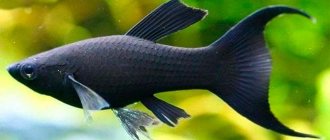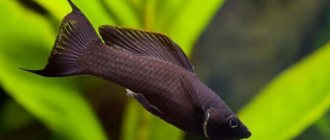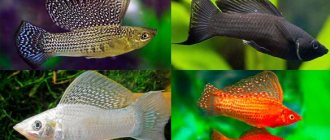Are neighbors really not important to molly?
It turns out that this is not the case either. Despite the fact that mollies, like all platies, are very sociable, they will be against the proximity of aggressive individuals, both large and small. They are very careful about their pride - their fins and curly tail. Therefore, neighbors who have a tendency to bite their neighbors off are unlikely to be suitable.
A good microclimate will develop in the aquarium if you add swordtails, gourami, and lalius to the molly. You can even use goldfish, as long as they are not larger than the molly itself. The principle should be the same: all individuals should populate at the same time and be approximately the same size.
Under favorable conditions, black mollies are capable of interbreeding with swordtails. As a result, very beautiful and distinctive red-black fish were obtained, similar in their way of life to all platies.
Swordtails
The swordtail in nature has a pale red or greenish color, but thanks to selection, more than fifty color variations of yellow, red, orange, black and combinations of these colors have now been bred. Albino forms are also fixed. Size 7-10cm. The swordtail, a fish native to Central America, is found in the waters of Mexico, Goduras and Guatemala. The fish is found both in still waters and in flowing rivers, and sometimes in very small puddles and ditches. This species is known for the xiphoid process on the tail of the males. Thanks to him, it got its name. At the end of the 19th century, the fish appeared in European aquariums; a little later, the swordtail was brought to Russia, where it became one of the most popular aquarium fish.
Reproduction of mollies is a special story
From the age of 5-6 months, the female molly is ready to reproduce.
In males, this period begins a little later - at about a year. Mollies are viviparous fish, which can reproduce every 40-45 days.
The maturation of the cubs occurs inside the female after fertilization with the seminal fluid of the male. It gets inside the molly through a special organ. However, it is not always possible to fertilize all the eggs at once. Therefore, their maturation can occur gradually: cubs can be born within a week or two.
Description and features
Mollies are small fish from the genus Poecilia.
History of discovery
It was first described by the Frenchman Achille Valenciennes during his work on “The Natural History of Fishes” in 1846. It is a variety of mollies sphenops, but at the turn of the 19th and 20th centuries two more came up to its description - velifera and free one. They were classified as mollies by the British ichthyologist Charles Tate Regan, who worked on the systematization of fish species.
Initially, mollies were classified as a separate genus. But according to modern classification, they belong to the genus Poecillia, and the name mollies itself is only a tribute to the historical definition.
The first wild mollies were brought to Europe in 1913, and their active selection began in 1920. Hybrids of wild species of mollies began to appear everywhere. The first black-spotted forms appeared in 1925, and the legendary Black Molly was created in Moscow in 1948. One of the last to be introduced were cylinders with an unusual body shape.
Habitat
It is quite wide, and actually covers both American continents. But they are most common closer to the mouths of rivers that flow into the ocean, and prefer slightly brackish water.
Lifestyle
This is a viviparous fish species that reproduces several times throughout the year. Pregnancy of females lasts from 26 to 35 days, after which from 28 to 80 fry are born, 6-8 mm long.
The fish feed on small crustaceans, insect larvae (including mosquitoes and flies), other invertebrates, and also quite actively on aquatic vegetation.
Appearance
The body of mollies has elongated proportions, slightly compressed laterally. The size of males is 5-6 cm in length, females are 7-8 cm. The head of the fish is small, with fairly large eyes. The fish have small, neat fins, with the exception of the velifera, whose dorsal fin is long and high. The anal fin of males is pointed, while that of females is round.
The natural coloring of the fish is quite inconspicuous - grayish-yellow with small, non-contrasting specks. But breeders developed a lot of brightly colored breeds - black, white, yellow, red, silver-blue. Thanks to selection, species with a variety of body shapes and fins have appeared.
Natural views
Since the distribution of mollies covers a fairly wide area, their genus includes 33 species of these fish. Let's look at the most famous of them.
Mollies sphenops or small-finned
The mollies sphenops fish has a relatively dense body, flattened laterally. All of its fins, including its tail, are small and rounded. The fish size is 6-10 cm, and females are always slightly larger.
The natural color of sphenops is unattractive. The upper part of the body is grayish-green, the lower part is silver-gray.
Freestyle
For a long time it was considered a variation of Sphenops in color, but later it was classified as a separate species. Its homeland is the reservoirs of Guatemala.
The natural color of the body is grayish-yellow. The fins and tail of males are carmine orange with black speckles. Older males have richer colors. Females have gray fins and tail.
Velifera or sailing
This is one of the most spectacular types. The name is given for the high upper fin of the males. This species is the largest. Females grow up to 14 cm, and in natural conditions up to twenty. The fish originate from Southern Mexico.
The natural color of the body is silver with intermittent longitudinal lines. Males have an orange head and belly. The tail is orange in the center with blue speckles and with a turquoise border along the edges, the upper fin is with an orange or black border. Females are entirely greyish-green, with darker broken lines along the body.
Latipina or broadfin
These aquarium fish are similar to the molly velifera species, only a little smaller. They have dimensions of up to 10 cm in an aquarium and up to 17 cm in their homeland. The high upper fin is rectangular in shape.
The body color is brown-silver, with darker and bluish speckles. The belly is orange, the fins have a blue central part with dots and streaks and an orange border.
Peten
The name of the fish comes from its location - Lake Peten Itza in Guatemala. Males have a sword-shaped appendage at the bottom of their tail, which is why they are often confused with swordtails. The color of these fish is silvery-pearl, with a red border of the fins.
Dwarf
The name corresponds to the size not exceeding 3-4 cm. It comes from Mexico.
The fish are yellowish-brown, with golden dots on the sides. The scales of a dominant male may have a bluish metallic sheen.
INTERESTING: The beautiful or Amazonian molly poecilia formosa comes from the lower Amazon. It is unusual in that it is capable of reproducing through gynogenesis. As a result, females fertilize the milk of other related species, and all offspring are exclusively female. This species is practically not kept in aquariums.
Breeding forms
Almost no one keeps wild mollies now. Aquarists prefer bright hybrid artificially bred breeds. Over 100 years of work by breeders, a huge number of new forms and colors of mollies have been obtained. Let's look at the most popular of them.
Gold
This is a large group of mollies, united by a yellow-orange color with a bluish-white tint. Many individuals have red eyes.
Silver or snowflakes
This group has a white color with a pearlescent blue tint. Their scales sparkle like snow in the sun, hence the name. They reach 8-10 cm.
Marble
Marbled molly is also a color variation and not a specific breed name. A characteristic feature is a mass of black spots of irregular shape, somewhere connecting with each other, on a general white or yellowish-light background. In this case, black color predominates over the others. It is the volume of dark specks that distinguishes this form from the Dalmatian molly, which is also covered with black dots, but in much smaller quantities.
Cylinders
When hybridizing fish, individuals with a short body and the same organ sizes were selected. The result was a shape with a unique structure, similar to a balloon. Any color: black, white, silver, yellow, red, etc.
Lyrebirds
The main feature of this form is the structure of the tail, the outer rays of which are longer than the middle ones. As a result, the rear edge of the tail forms a curve similar to the outline of a lyre. Any color, without highlighting any main color.
Popular aquarium species
There are many types of mollies, and they all differ in the shape of individual parts of the body, as well as size and color.
Black molly
Black mollies are most widely distributed both in professional stores and in markets. The velvety surface of the skin of this fish looks luxurious. But the next generation does not always look like its parents - gray-yellow fry often appear.
Dalmatian or silver spotted mollies
The color of these fish resembles Dalmatian dogs. They have silvery-white scales with random black spots. The length of the fish can vary from 5-6 to 12-13 cm.
Coffee Velifera
This is a fairly rare breed with a rich brown-coffee body color and speckled fins and tail.
Red leopard
These fish have an intense red coloration with black spots.
Orange
These are golden-orange fish, up to 6-7 cm long. Sometimes there are orange fish with a black tail.
Yellow
Yellow mollies include all shades of this color, sometimes with black, white or reddish admixtures. The color of a particular individual depends not only on genetics, but also on the conditions of detention.
Highfin green
Color subspecies of molly latipin. The color is extremely light, almost colorless, with many greenish spots. Grows up to 6 cm.
Highfin orange
Color subspecies of molly latipin. The fish is light orange, with a brighter belly, and is all covered with small specks of a soft blue color. The dimensions of the fish are 7-12 cm.
Black lyrebird
One of the variations of the black molly, differing in the shape of its tail.
Two-color
The bicolor molly is a hybrid species with a deep black tail and the rest of the body in rich warm shades. They are also found with completely black scales, as if sprinkled with golden dust. Their eyes are black with a thin silver rim.
IMPORTANT: To maintain the color saturation of all yellow, orange and red fish, it is recommended to add foods containing carotene to their menu.
What is needed for the development of fry?
First of all, you should take care of the freshness of the water in the aquarium, its aeration, and proper filtration. A minimum weekly change of a quarter of the volume of water is required; it must be settled, slightly warm, and free of bacteria and even snails.
Secondly, you need appropriate nutrition. Molly fry love naupliiartemia, cyclops, “living dust” . You can also treat them with artificial food for fry. Like adults, molly fry will not refuse plant foods, both frozen and freshly pureed: cucumber, zucchini, squash and others.
Excess food must be removed after 20 minutes, since its beginning rotting process will provoke biological pollution of the water.
Pecilia
Platies habitat: Central and North America. Pecilia is a small fish, body length is 3 - 4.5 cm. Unpretentious, beautiful, with a variety of colors, easy to breed, it has become very popular among aquarists. Just like mollies, appearance and color are very variable. Common breeds: disc platie, radish, coral, Mickey Mouse, Hawaiian, etc.
Swordtails, platies and mollies belong to the platies family and are low-maintenance viviparous fish that are suitable for beginners.
They prefer fresh water with the following parameters: t 24-27 degrees, gH 8-25, pH 7-8. It is advisable, although not necessary, to add sea aquarium salt to the water, no more than three grams per liter. A weekly water change of 15 to 20% is required. The ideal volume of water for their maintenance will be from 50 liters. It is better to decorate the aquarium with live plants so that newborn fry have a place to hide from adults who can eat them. In the first day, two of them are vulnerable, and then they can swim freely with their parents. Viviparous species are not picky about food, can endure long hunger strikes of up to 10 days and prefer to eat plant foods. You should also occasionally give protein food in the form of cyclops, small bloodworms, daphnia and tubifex. The fry can be fed with sera micron fry food, TETRA MIN BABY and live brine shrimp nauplii.
How to help fish if they are “out of sorts”?
An experienced aquarist will immediately advise salting the water in the aquarium. The calculation is simple: a tablespoon of ordinary table salt per 10 liters of water. Second step: bringing the temperature to 27o.
These are the conditions that are natural in the main habitat. Therefore, they are an incentive for reproduction, disease prevention and a guarantee of a good mood for these universal favorites - mollies.
Now it is clear that the “simple and unpretentious” mollies will become so only when all its requirements and whims are met!
Post Views: 7,278
Popular types
All modern species and breeds of mollies are morphs obtained as a result of crossing natural species. The sizes of fish living in aquariums are smaller than those living in natural reservoirs. The life expectancy of hybrid forms is shorter, 2-3 years.
The most common types:
Black mollies (molly lyra)
The most common type has a black velvety color, often with a metallic olive tint. The fish is unpretentious and is recommended for breeding for beginners. Lyra mollies are distinguished by their elongated tail, curved on both sides.
Mollies orange
Sphenopsis hybrid, yellowish-golden fish, body length 6-7 cm. It is unpretentious. There are two-color orange and black forms.
Silver spotted molly (Dalmatian)
There are speckled black spots scattered against the light background of the body color. The size of the fish is 6 cm.
Silver mollies (Snowflake)
The body of the fish is white with a blue tint, 8-10 cm long. Unpretentious, easy-going.
Mollies balloon
A breeding form of the broadfin molly, a fixed genetic mutation. The body of the fish with a curved spine and convex abdomen resembles a barrel. Fish are susceptible to disease and rarely live more than 2 years.
Who do they get along with best and with whom should you absolutely not live in the same aquarium?
Swordtails are most compatible with peaceful, proportionate species:
They are able to get along well with Barbs and Angelfish, as well as catfish (Coridoras and Ancistrus).
Goldfish, Bettas and veiled varieties often suffer from Swordtails, as the latter are attracted to the long translucent fins. The Swordtails themselves act as victims in front of aggressive cichlids (Astronotus, Cichlasomas), so under no circumstances should they be kept together.
If you follow these recommendations, different types of aquarium fish will be able to live harmoniously in one aquarium and delight their owner.
Breeding swordtails at home for beginners
Since this is a viviparous fish, any beginner can cope with the reproduction of swordtails at home. When good conditions are created, mating usually occurs in a common aquarium. What does a pregnant female swordtail look like? Her belly takes on a rounded shape and, as she approaches childbirth, becomes angular, as if square. Before giving birth, the female swordtail tries to retire in the midst of plants, and by this sign one can determine the beginning of the process. At this time, the female needs to be placed in another vessel with small-leaved plants. Unless, of course, you intend to preserve your offspring. By the way, a once fertilized female can bring fry several times without the participation of a male.
Pregnant female swordtail
The fry are born after about 40 days. A large female is capable of giving birth to about a hundred or more fry. They are fully formed and can immediately begin to feed.
What to feed swordtail fry in the first days? Children eat small, protein-rich food:
- Artemia
- Cut tubifex
- Nematodes
- Boiled yolk
- Industrial feed for fry
Malek
That's all the wisdom. You can transplant the fry into a common jar when they cannot be eaten by the older inhabitants.
Possible diseases and prevention
Any aquarium fish can get sick; most often, pathologies arise due to violation of living conditions - poor-quality feeding, hypothermia, stress.
Platies are quite resistant to many types of aquarium diseases. But there are known cases of infection with ichthyophthoriosis. The causative agent is a parasitic ciliate, which usually ends up in a body of water with low-quality food.
Affected fish begin to sink to the bottom and scratch themselves on the ground. The fins are deformed, compressed, and white grains appear on them.
Sick individuals must be removed and treated. A weak saline solution, Bicillin-5, Rivanol helps well.
It is advisable to rinse the aquarium, siphon or boil the soil, replace the water, add salt (at the rate of no more than 10 g per 1 liter).
Feeding complete live food will also help the fish quickly regain their lost shape and restore their immune system.
Overview of aquarium fish types
Swordtails must be kept in a school, otherwise they begin to conflict with other fish. In addition, there should be more females than males, since the “boys” actively compete with each other. One male is also capable of disrupting the harmony in the aquarium, as he will inevitably begin to attack weaker individuals: both relatives and neighbors.
Attention! To avoid conflict situations, you should create a flock of Swordtails, which will have at least 3 males and 4-5 females.
Guppy
It is believed that Swordtails love to chase peaceful little Guppies. In reality, they only pay attention to fry or sick fish that are clearly unable to fend for themselves.
On the left is Guppy, on the right is Swordtail.
Swordtails can nip guppies, eating their tail or fins. If the aquarium is large enough and has several hiding places, then the likelihood of conflicts between Swordtails and Guppies is reduced to zero.
Gourami
Gourami is another peace-loving species that almost never conflicts with its neighbors. Swordtails, in turn, have a similar character and preferences for living conditions, so these two species get along well in the same aquarium.
Mollies
To keep these fish together, you should provide a large amount of free space, since in cramped conditions they begin to actively conflict over territory. It is curious that male Swordtails can sometimes pester female Mollies. From the outside it looks like an active game that will not bring any consequences.
Angelfish
Unlike previous species, Angelfish often experience the unhealthy interest of Swordbearers. The fact is that these fish have long fins that attract cocky “swords”.
You should not introduce Angelfish into an aquarium with Swordtails; the “owners” will probably begin to aggressively hunt them.
Possible conflicts can only be avoided if fry or young individuals are raised together . So the fish do not see each other as enemies.
Barbs
Barbs are playful, cocky fish that love to chase slower neighbors. Swordtails, in turn, also behave actively and energetically, but their unusual fins often become a real bait for Barbs.
To protect the “swords” from the pursuit of the Barbs, you need to arrange reliable shelters in the aquarium and plant more plants.
Thanks to this measure, even young Swordbearers will be able to hide from the angry Barbs and wait until they turn their attention to something else.
Danio
Danios are small, peaceful fish that almost never conflict with their neighbors. Swordtails are larger than them, but clashes between these species are extremely rare. Aggressive behavior only occurs if the aquarium is overpopulated, since even peaceful fish defend their territory.
Sometimes aquarists believe that sudden aggression (that is, everything was fine before, but after a while it “started”) can be caused by poor maintenance and care of Swordtails, in fact this is not the case, the whole problem is the compatibility of the fish.
Ternetia
Ternetias, although they are relatives of piranhas, have a very peaceful character, thanks to which they get along well with all sized fish. Swordtails are no exception to this rule, so these species can be safely placed in the same aquarium.
Compatibility of swordtails with other fish
I repeat that the swordfish is a peaceful fish, which should be planted in the same jar with the same peaceful fish. However, sometimes swordsmen squabble among themselves. This is mainly due to the small number of females. It is recommended to count more than two females per male. And the number of males should be more than two in order to disperse the attention of rivals.
Swordtails are compatible with guppies
Suitable fish to keep with swordtails are:
- Guppy
- Gourami
- Danio
- Discus
- Labeo
- Mollies
- Cockerels
- Pecilia
- Plecostomus
- Rainbows
- Rasbory
- Angelfish
- Tetras
Here you need to look at the displacement of the aquarium. If your bank is like Tokyo, there will probably be problems.
Limited compatibility with:
- Axolotls
- Barbs
- Shrimp
- Sword bearers
- Acne
Completely incompatible with:
- American and African cichlids
- Astronotuses
- Goldfish
- Koi carp
These cute fish will happily snack on swordtails, so it's best to stay away from them.
Compatibility table of the swordtail with other fish
Adviсe
- If overfeeding occurs, immediately remove excess food from the aquarium with a net.
- When purchasing fish food, carefully study the expiration date and storage conditions. Avoid loose feed.
- When breeding fish, select fish of the same variety, so the offspring will be purebred.
- When spawning, remember that a lot of offspring appear. Make sure you have a large aquarium.
- When buying pets in a store, carefully inspect the fish. She should not show signs of illness.
- New fish should be introduced into the aquarium gradually. First, place the bag in the aquarium for half an hour, then pour some aquarium water into the shipping bag. Gradually add aquarium water.
Pecilia is a beautiful and unpretentious fish that is perfect for beginners. An interesting feature: if the conditions of detention change sharply, the fish changes sex. Thus, the female becomes a male.
Previous Fish7 popular aquarium cichlid fish and their maintenance Next Fish16 types of koi carp for the aquarium
Conditions for peaceful detention
The main condition for peaceful maintenance is a large space. In a compact aquarium, even peaceful inhabitants conflict. Each species must have a place to move. If there is not enough space, the best solution is to place the species in separate aquariums.
Another condition is a comfortable life for each pet. Do not introduce nimble, voracious individuals. They eat all the food, leaving others hungry.
For peaceful coexistence of pets, purchase them at a young age. Inhabitants who have grown up together are not prone to conflict, unlike adult individuals who have been housed together.











